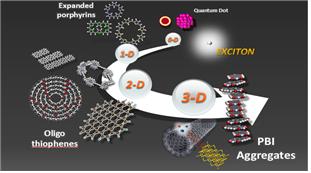A Journey to Molecular Excitonic World
Various synthetic strategies have been developed to devise a variety of artificial molecular arrays in molecular photonics because of their similarities in architecture and subunit structures to the natural photosynthetic light-harvesting complexes. For the molecular arrays to be efficient devices, they should have very regular pigment arrangements which allow a facile light energy or charge flow along the array but do not result in the alteration of individual properties of the constituent pigments leading to the formation of energy or charge sink. In these respects, understanding of photophysical properties of these macromolecular architectures is essential for the rational design of molecular devices for photovoltaic, or optoelectronic applications.
Here, we have revealed that the ultrafast excitation energy migration processes in molecular arrays are strongly influenced by the electronic couplings among the constituent molecules as well as the structural rigidity of overall architectures.[1] Our investigations have been extended to H-type aggregated perylenebisimide (PBI)[2] and polythiophene oligomers (linear vs. cyclic)[3]. Not only intermolecular exciton couplings but intramolecular electronic structures have been investigated in a series of expanded porphyrins in conjunction with their molecular structures, the number of π-electrons (Huckel’s [4n+2] rule) as well as their conjugation pathways. Our study demonstrates a relationship between the photophysical properties such as absorption/emission properties, excited state dynamics and the aromaticity of expanded porphyrin systems. Based on these spectroscopic observations, we have found the reversal of aromaticity in the excited states of aromatic/antiaromatic expanded porphyrin congeners.[4] Detailed studies of the modulation events are expected to provide additional fruitful insight into the relationship between (anti)aromaticity and electronic structures. To the extent this proves true, it could have far-reaching practical applications that complement the advances in theoretical understanding that our studies are likely to provide.

Fig. 1 Excitonic dynamics in various molecular systems
Acknowledgement(s) This work was supported by Samsung Science and Technology Foundation under Project Number SSTF-BA1402-10 and the Global Research Laboratory (GRL, 2013K1A1A2A0205183) Program funded by the Ministry of Education, Science and Technology (MEST) of Korea.
References
[1] J. Sung, P. Kim, B. Fimmel, F. Würthner, D. Kim, Nat. Commun., 6 (2015) 8646.
[2] Y. M. Sung, M.-C. Yoon, J. M. Lim, H. Rath, K. Naoda, A. Osuka, D. Kim, Nat. Chem., 7 (2015) 418-422.
[3] Y. M. Sung, J. Oh, W.-Y. Cha, W. Kim, J. M. Lim, M.-C. Yoon, D. Kim, Chem. Rev., 117 (2017) 2257-2312.
[4] W.-Y. Cha, T. Kim, A. Ghosh, Z. Zhang, X. Ke, R. Ali, V. M. Lynch, J. Jung, W. Kim, S. Lee, S, Fukuzumi, J. S. Park, J. L. Sessler, T. K. Chandrashekar, D. Kim, Nat. Chem., 9 (2017) DOI:10.1038/nchem.2834.